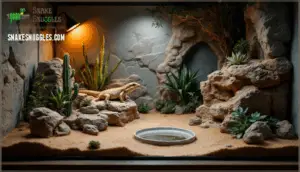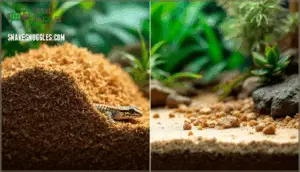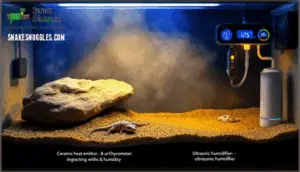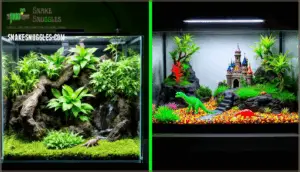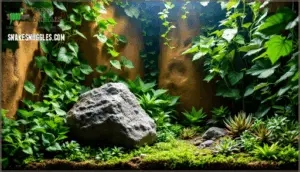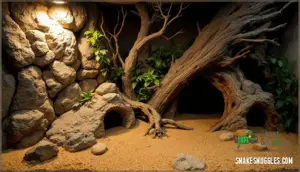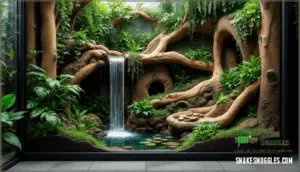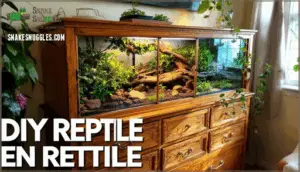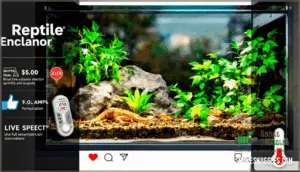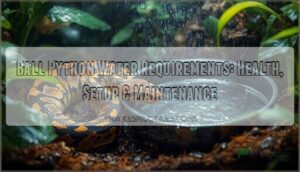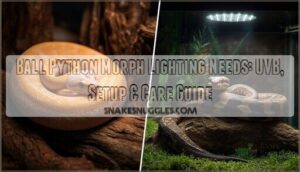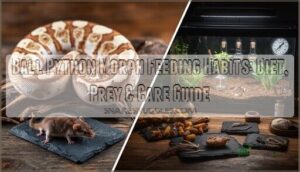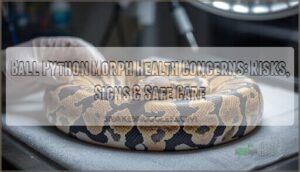This site is supported by our readers. We may earn a commission, at no cost to you, if you purchase through links.
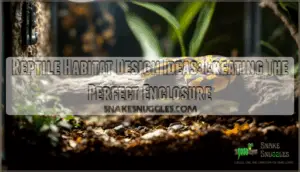
The difference between a thriving reptile and one barely surviving often comes down to how well the enclosure mirrors natural conditions. Temperature gradients, substrate depth, and vertical space aren’t just aesthetic choices—they directly affect your reptile’s ability to thermoregulate, hunt, and exhibit species-specific actions.
Whether you’re setting up your first terrarium or redesigning an existing space, understanding the connection between habitat structure and animal welfare changes everything about reptile care.
Table Of Contents
- Key Takeaways
- Choosing The Right Reptile Enclosure
- Replicating Natural Reptile Habitats
- Substrate Selection and Placement
- Temperature, Lighting, and Humidity Solutions
- Landscaping and Decorative Features
- DIY and Custom Habitat Ideas
- Maintaining a Healthy Reptile Habitat
- Frequently Asked Questions (FAQs)
- Conclusion
Key Takeaways
- Proper enclosure size directly impacts stress levels and natural behaviors—ball pythons over three feet need minimum 48×24×24 inch spaces, and inadequate dimensions can reduce exploratory activity by up to 40% while increasing stereotyped stress behaviors.
- Temperature gradients aren’t optional decoration but survival tools that allow reptiles to thermoregulate by moving between basking zones (90-110°F) and cooler areas (75°F), since reptiles can’t internally regulate body temperature like mammals.
- Substrate choice affects both health outcomes and natural behaviors—proper depth enables burrowing species to exhibit instinctive actions while maintaining humidity gradients, and wrong materials like calcium sand cause impaction in 9-11% of veterinary cases.
- Environmental monitoring with digital sensors and UVB measurement tools prevents the guesswork that leads to metabolic bone disease, respiratory infections, and shedding complications seen in 45% of poorly maintained enclosures.
Choosing The Right Reptile Enclosure
Your reptile’s enclosure isn’t just a container—it’s the foundation of their entire world. Getting this choice right means understanding how size, materials, and layout work together to meet your pet’s needs.
Let’s break down what you need to think about when selecting the perfect home for your scaly companion.
Enclosure Size Considerations
How do you determine the right enclosure size for your reptile? Start by understanding that minimum dimensions depend heavily on species conduct and growth potential. Ball pythons over three feet need at least 48 × 24 × 24 inches. Welfare impacts are significant—snakes unable to stretch fully show elevated stress. A 4x2x2 enclosure is a baseline for ball pythons.
Consider these core factors:
- Match tank dimensions to your reptile’s adult body length using species-specific ratios
- Provide vertical space for climbing species to support natural actions
- Plan for enrichment needs that improve natural variety by up to 40%
Proper enclosure size considerations prevent stereotyped actions and support thermoregulation throughout your reptile’s life.
Enclosure Materials (Glass, PVC, Wood)
Once you’ve settled on the right size, the material you choose shapes how well your enclosure holds heat and resists wear. Glass panels offer 100% visibility and disinfection ease but lose heat 20-25% faster than alternatives. PVC Jungle Gym setups retain warmth up to 20% longer and weigh 40-60% less than glass—ideal for stacking or moving. Wood finish enclosures provide enhanced insulation but need resealing every 1-2 years. Watch for VOC emissions in low-quality PVC when temperatures exceed 140°F.
Material lifespan and weight comparison matter when planning DIY reptile enclosure construction for reptile enclosure materials that last. PVC enclosures also offer superior heat retention, making them ideal for maintaining stable temperatures.
Vertical Vs. Horizontal Layouts
Your enclosure design will directly influence how your reptile moves and thrives. Arboreal reptiles need vertical space to express climbing habits—Crested Geckos in tall setups show 50% more natural activity. Terrestrial needs differ: Ball Pythons use horizontal layouts for burrowing and basking, with 35% more foraging in wider enclosures. Space optimization matters because behavioral impact shows in health outcomes.
Consider these habitat design principles:
- Arboreal species require 18×18×24" minimum with 50%+ foliage density
- Terrestrial reptiles need 48×24×24" minimum for floor-based actions
- Vertical enclosures create 6°C temperature gradients base-to-canopy
- Horizontal layouts reduce stress-related issues by 23% when sized correctly
- Bearded dragons use under 20% of vertical zones—prioritize width instead
Escape Prevention and Safety Features
A secure enclosure is your first line of defense against escapes. PVC and metal enclosures with locking mechanisms cut escape rates by over 90% compared to unsecured glass tanks. Top-opening terrariums with dual latch systems perform even better—97% fewer escapes in small snakes.
Material strength matters too: PVC panels show three times the impact resistance of tempered glass. Fine mesh ventilation screens keep even tiny reptiles contained while maintaining airflow. Seal gaps larger than 3 mm with silicone caulking to prevent 95% of potential escapes.
Room containment adds another layer—dedicated reptile spaces with sealed windows reduce multi-enclosure incidents by 92%.
Replicating Natural Reptile Habitats
Replicating your reptile’s natural environment isn’t just about aesthetics—it’s about survival. Different species evolved in vastly different ecosystems, from scorching deserts to humid rainforests.
Let’s explore the core habitat types you can recreate to match your pet’s specific needs.
Desert Habitat Design Ideas
Building a desert habitat means replicating arid landscapes with the right mix of substrate, lighting, and temperature control. You’ll need a blend of 60–70% topsoil and 30–40% play sand for your base layer.
Basking zones should reach 90–110°F while ambient areas stay between 65–85°F. Use UVB bulbs like ReptiSun 10.0 for 12–14 hours daily to support vitamin D3 synthesis.
Add rocks, hides, and non-spiny succulents to create a functional desert oasis with proper enrichment.
Tropical Rainforest Enclosure Concepts
Tropical rainforest enclosures replicate dense jungle conditions with 60–80% humidity gradients and 24–30°C ambient temperatures. Vertical complexity is essential, utilizing live plants like Ficus pumila and cork bark to accommodate climbing species.
Bioactive integration with springtails and isopods maintains substrate health, while airflow management through mesh tops prevents mold. Layering sphagnum moss over drainage gravel controls moisture, and UVB lighting for 10–12 hours daily supports tropical species.
Forest Floor and Savannah Setups
Forest substrates mimic woodland biomes where many terrestrial species thrive, while Savannah Configuration suits monitors and ground-dwelling reptiles from arid grasslands. Consider these setups for replicating natural habitats:
- Forest Floor Fun – Use 30–60 cm substrate depths with coconut coir and leaf litter to maintain 60–80% humidity, plus mixed log arrangements spaced 25 cm apart for climbing.
- Arid Savannah Setup – Layer coarse sand and topsoil exceeding 45 cm deep, add flat stones reaching 38–42°C for basking, and scatter driftwood for 50% increased foraging activity.
- Layering Benefits – Incorporate gravel drainage below organic soil to reduce waterlogging by 80%, and use mesh barriers between layers to simplify cleaning by 30%.
Decorative features like rock piles and artificial grasses boost natural actions.
Environmental monitoring with digital sensors tracks temperature and humidity swings, enabling evidence-based adjustments for best conditions.
Aquatic and Semi-Aquatic Habitats
Semi-aquatic enclosures replicate ecosystems where turtles and amphibians flourish. Paludarium Design integrates 20–27 cm water zones with terrestrial basking areas to support both aquatic reptiles and aquatic plants. Tropical Paludarium setups boost Species Compatibility with submerged roots and proper water features.
Maintain Water Quality through filtration systems and weekly pH testing (6.5–7.0 range). Habitat Zoning creates temperature gradients from 24°C cool spots to 32–35°C basking platforms. Safety Enhancements like dual front doors prevent escapes.
Substrate Selection and Placement
Choosing the right substrate isn’t just about looks—it directly affects your reptile’s health and actions. Different species need different materials to stay comfortable and thrive.
Here’s what you need to know about selecting and placing substrate in your enclosure.
Best Substrates for Different Species
Choosing appropriate substrates means matching your pet’s natural environment to support health and natural instincts. Species substrate needs vary widely based on native habitats and physiological requirements.
- Bearded Dragons: A 33% play sand, 33% organic topsoil, and 33% excavator clay mix encourages digging while replicating natural Australian desert conditions
- Ball Pythons: Aspen bedding or a 70% topsoil and 30% play sand blend provides moisture retention for temperate forest species
- Leopard Geckos: DIY topsoil, sand, and clay mixes replicate arid scrub habitats while avoiding substrate impaction risks from calcium sand
- Crested Geckos: Coconut fiber and damp sphagnum moss maintain 70-80% humidity for tropical species while preventing substrate toxicity concerns
Mixing substrates safely requires understanding species-specific requirements and avoiding dangerous materials like walnut shells or wood shavings. Bioactive substrate benefits include enhanced enrichment and waste breakdown when creating suitable reptile environments.
Substrate Depth and Moisture Control
Substrate depth and moisture control work hand in hand to create the right reptile environment for your pet’s health. Ball pythons need 7.5–10 cm depths for humidity retention, while ackie monitors require over 30 cm to maintain 80% burrow humidity and support natural burrowing.
Deeper substrates create moisture gradients with up to 40% humidity differences between surface and bottom layers in tropical setups. Digital hygrometers embedded in substrate provide ±2% accuracy for monitoring methods that prevent the shedding complications seen in 45% of low-humidity enclosures.
Safe and Unsafe Substrate Options
Proper substrate selection for reptiles directly impacts health outcomes and long-term wellbeing. Natural sand with 9% fine particles and organic topsoil support burrowing while maintaining humidity between 10–15%. Bioactive soil mixes reduce ammonia buildup by 40% and cut cleaning frequency.
Avoid these unsafe materials:
- Cedar and aspen shavings – Cedar releases 5–10 times more phenols than pine when heated, irritating respiratory tissues and causing chronic stress.
- Calcium sand – CaCO₃-based products harden at body temperature and form digestive blockages linked to impaction cases representing 9–11% of reptile veterinary visits.
- Bark chips with resin – Untreated pine retains 12–15% resinous oils that trigger dermal irritation in desert species and compromise hygiene properties.
Proper hydration combined with suitable temperatures decreases impaction risks by over 70% even on loose substrates. Match substrate placement in reptile tanks to habitat suitability requirements—desert dwellers thrive on 60–80% sand mixtures while tropical species need coconut coir retaining moisture at 50–70% capacity for creating reptile environments.
Decorative Substrate Ideas
Beyond safety considerations, substrate layering creates visual enrichment in reptile decor. Coconut coir retains 8–10 times its weight in water, supporting tropical displays, while bioactive substrates incorporate topsoil and sand for natural burrowing habits.
Fine-grain sand appears in 85% of desert habitat design for arid landscape aesthetics. Color contrast using decorative black or white stones highlights your reptile’s natural coloration.
Mixed substrate placement in reptile tanks—sand over soil or bark on moss—produces gradient aesthetics in 60% of sophisticated setups.
Temperature, Lighting, and Humidity Solutions
Your reptile’s survival depends on getting three environmental factors right: temperature, lighting, and humidity. Each species has precise requirements that mirror their natural habitat.
Let’s break down how to set up these critical systems so your pet can thrive.
Creating Temperature Gradients
Your reptiles can’t regulate their body temperature like you do. They need temperature gradients across their enclosure to move between warmer and cooler thermal zones for proper thermal regulation.
Position heating equipment like heat lamps to create a basking area around 90–105°F while maintaining cooler spots near 75°F. Use gradient monitoring tools to track these thermal zones.
Species specifics matter since desert reptiles need stronger heat than tropical ones. Environmental factors like enclosure material affect how well your ideal temperature gradient holds.
UVB and Lighting Requirements
Getting temperature right is one piece of the puzzle. Lighting requirements for reptiles go beyond basic visibility since UVB lighting drives calcium metabolism and prevents metabolic bone disease.
You need UVB bulbs matched to your species using Ferguson zones as your guide. Here’s what to keep in mind:
- UVB intensity should measure 13–150 μW/cm² at basking spots depending on species needs
- Bulb replacement every 6–12 months prevents output decay even when bulbs still glow
- UVA integration bolsters color vision and natural activity alongside UVB exposure
- Photoperiod control maintains 12-hour light cycles with seasonal adjustments for temperate species
T5 high-output tubes work well for large enclosures while mercury vapor bulbs combine heat and UVB. Always position reptile lighting 30–60 cm from basking areas and measure output monthly with a UVI meter.
Humidity Control Techniques
Maintaining humidity levels can make or break your reptile’s health. Misting systems allow for rapid adjustments, while substrate moisture from coconut fiber and moss helps stabilize tropical enclosures. Water features, such as shallow pools, add localized humidity through evaporation, and humidity gradients enable reptiles to self-regulate.
Automated control systems with sensors oversee temperature and humidity control precisely. Balance ventilation systems carefully, as too much airflow drops moisture fast.
Monitoring Environmental Parameters
Without tracking temperature gradients and humidity control, you can’t maintain a stable environment. Digital thermometers and humidity sensors provide accurate readings, while UV measurement tools verify proper light intensity for calcium metabolism. Cloud-based data logging archives historical trends and aids long-term adjustments. Remote alerts notify you immediately when ventilation systems fail or moisture control drifts beyond safe limits.
- Place redundant sensors in large enclosures to catch localized variations
- Test UV output every six months as bulbs degrade over time
- Set programmable thresholds to trigger instant mobile notifications
- Review monthly trend reports to anticipate seasonal swings
Temperature and humidity control relies on consistent monitoring, not guesswork.
Landscaping and Decorative Features
Landscaping transforms your reptile’s enclosure from a basic container into a functional ecosystem that fosters natural instincts. The right combination of plants, structures, and features creates visual interest while meeting your pet’s biological needs.
Here’s how to build a habitat that balances form and function.
Naturalistic Vs. Themed Terrarium Designs
You can think of your terrarium design as either a nature documentary or a stage set. Naturalistic habitats mimic wild environments with realistic substrates and organic decor. Themed terrariums use synthetic ornaments and fantasy elements. Your choice affects behavioral enrichment, maintenance needs, and aesthetics.
| Design Factor | Naturalistic | Themed |
|---|---|---|
| Behavioral Enrichment | 32% increase in exploratory activity | 22% reduction in species-typical actions |
| Maintenance Needs | Weekly substrate replacement, daily spot checks | 30% less cleaning time with synthetic materials |
| Setup Cost | Average $275 for high-end enclosures | Average $192 for equivalent size |
| Aesthetics | Realistic rocks, wood, native vegetation | Fantasy figures, dinosaur motifs, pop-culture elements |
| Market Trends | 54% of premium purchases favor naturalistic designs | 14% of decorative accessory sales |
Naturalistic setups increase stress reduction and encourage natural activities. Themed designs offer easier rearrangement and lower replacement costs. Many owners now combine both approaches in adaptable enclosures. Safety concerns apply equally—make sure all materials are non-toxic regardless of your design choice.
Incorporating Live and Artificial Plants
Live plants act as your terrarium’s life support system. They regulate humidity through transpiration and create microclimates while supporting bioactive substrates with beneficial organisms. You’ll need safe plants for reptiles like Pothos or Spider plants—nontoxic plants that tolerate grazing.
Artificial plant life offers maintenance balance without watering or pest risks, perfect for beginners. Many keepers mix both for aesthetic appeal and reduced upkeep.
Match your reptile terrarium plants to your species’ humidity needs and lighting setup.
Rocks, Branches, and Hiding Spots
Your reptile habitat transforms when you add strategic hardscape elements. These features do more than decorate—they regulate temperature and reduce stress.
- Rocks create basking zones reaching 40°C under lamps for thermoregulation
- Branches placed at angles increase vertical movement by 47% in arboreal species
- Multiple hides cut stress actions by 55% when positioned near heat sources
- Natural materials like bark are occupied 31% more than plastic hideouts
- DIY enrichment costs 48% less than commercial options while boosting exploration
Secure heavy rocks and branches to prevent accidents. Smooth sharp edges to cut injury rates by nearly half.
Water Features and Climbing Structures
Water features and climbing structures work together like a natural ecosystem. Running water boosts humidity by 10–15% and increases hydration rates by 30% in tropical species. Position waterfalls at low points for efficient flow and keep depths under 5 cm for safety.
Vertical space utilization should reach 70% of enclosure height. Use cork bark or manzanita wood for climbing safety—these rot-resistant structural materials support shedding and reduce obesity.
Bioactive integration with aquatic plants improves water quality while creating authentic reptile habitat design.
DIY and Custom Habitat Ideas
Building your own reptile habitat opens up creative possibilities while keeping costs down. You can transform everyday furniture into functional enclosures or design themed terrariums that reflect your personal style.
Let’s explore some practical DIY approaches that balance your reptile’s needs with creative design.
Repurposing Furniture for Enclosures
You can transform old furniture into functional reptile enclosures with careful planning and modification. While commercial tanks may cost $600 to $1,200, converting secondhand pieces usually runs just $150 to $400—substantial cost savings that also reduce waste.
Here’s what you need to focus on:
- Furniture Sealing: Apply aquarium-grade silicone to all interior surfaces, since over 70% of conversions require complete waterproofing to prevent wood warping and structural failure.
- Ventilation Needs: Drill 20 to 25 holes per cubic meter of enclosure volume to maintain proper airflow and prevent dangerous condensation buildup.
- Structural Integrity: Reinforce corners with steel brackets to cut collapse risks in half, especially when working with particleboard or MDF materials.
- Access Design: Install front-opening doors to reduce interaction stress by 20 to 30% compared to top-entry designs.
- Material Protection: Use automotive-grade epoxy coatings to reduce water absorption by up to 90% in wooden panels.
Choose vertical cabinets for arboreal species or horizontal dressers for terrestrial reptiles. Install glass or acrylic front panels for visibility while maintaining humidity control. Your customization options for DIY reptile enclosures are nearly limitless when repurposing furniture for reptiles, but never skip waterproofing—around 40% of conversions fail within a year without proper sealing.
With correct modifications, your reptile habitat can last five to eight years while blending seamlessly into your home.
Multi-Layered and Space-Saving Designs
When floor space runs tight, stacking enclosures vertically can save up to 40% of your room’s footprint. Modular PVC systems let you expand upward or sideways as your collection grows, while cutting heat loss by roughly 25% compared to glass. Vertical setups create natural thermal layering—top zones run 2 to 4°C warmer, perfect for basking spots. This approach boosts behavioral enrichment too, since arboreal species get more climbing room and exhibit 25% more exploratory movement.
| Design Feature | Key Benefit |
|---|---|
| Modular frames | Expand in any direction as needs change |
| Vertical stacking | Saves 40% floor space in small rooms |
| Layered heat zones | Top areas stay warmer for basking |
| Multi-tier perches | Increases exploratory behavior by 25% |
| Built-in cable routing | Cuts maintenance time by 30% |
Space optimization doesn’t mean sacrificing comfort—it means working smarter with the room you have.
Fantasy, Vintage, and Themed Terrariums
Building a terrarium doesn’t mean sacrificing creativity for function. Fantasy hardscapes assembled from driftwood and decorative stones let you craft enchanting landscapes while maintaining proper drainage and substrate layers. Vintage bottles from the 1940s to 1970s give your setup character at budget-friendly price points. Themed composition follows the 40-60 rule—40% hardscape, 60% open space—so your reptile moves freely while you showcase your design vision. Technical construction matters: layer lava rock, activated carbon, and specialized soil for plants like Anubias nana to thrive. The reptile enclosure market’s growth to $2.16 billion by 2030 shows demand for custom themed terrarium setups beyond generic boxes.
- Fantasy hardscapes: Glue driftwood pieces together with Leucobryum moss for mystical forest floors
- Vintage bottles: Hunt demijohns or apothecary jars for one-of-a-kind DIY terrarium ideas
- Themed composition: Place focal points using the golden ratio for visually balanced reptile terrarium design
- Technical construction: Add springtails to your vintage suitcase terrarium or custom themed terrarium for mold control
Cost-Effective DIY Materials and Tips
Themed setups look impressive, but you don’t need to overspend. DIY PVC enclosures cost $150–$200 versus $342–$417 for prefabricated units. Upcycled enclosures from old bookcases save $150–$250 while offering the same functionality.
MDF sheets, running $30–$50, provide excellent thermal stability when sealed. Budget lighting options like incandescent bulbs serve dual duty as heat sources at $6–$20 each. Cheap substrates like ReptiBark retain moisture effectively, reducing misting needs by 25–40%.
Always verify material safety—avoid pine and cedar because they release harmful compounds.
Maintaining a Healthy Reptile Habitat
Building a beautiful habitat is only half the battle. Keeping it clean and stable determines whether your reptile actually thrives.
Let’s walk through the key routines that prevent problems before they start.
Regular Cleaning and Maintenance Routines
Your reptile tank maintenance routine directly impacts your pet’s health. Daily spot cleaning removes waste and uneaten food to prevent bacterial growth. Weekly disinfection using reptile-safe products like F10SC controls pathogens. Complete substrate changes every 1-6 months maintain biosecurity control. Clean water bowls daily and scrub habitat accessories when dirt appears.
These hygiene practices reduce respiratory infections and keep ammonia levels low. Proper waste management and filter maintenance create a healthier environment for your reptile.
Disease and Injury Prevention
Quarantine procedures prevent the spread of disease before it starts. New reptiles need 30 to 90 days of isolation in a separate space with no shared airflow. Here’s what keeps your enclosure safe:
- Use non-porous materials like PVC or glass to allow thorough disinfection between cleanings.
- Replace sharp-edged decor since untreated rocks cause soft tissue injuries in 12% of captive reptiles.
- Anchor climbing branches securely to support 1.5 times your reptile’s weight and prevent falls.
- Check heating elements weekly to avoid thermal burns and overheating hazards.
- Maintain proper temperature gradients with 10 to 15°C variation to reduce metabolic bone disease risk by 40%.
Safe materials and hygiene management create injury prevention systems that work.
Stress Reduction for Reptiles
When you add hiding spots and climbing structures, you’re doing more than decorating. Enclosure complexity reduces stress responses by up to 60% in commonly kept species.
Environmental enrichment through varied substrates and thermal gradients lowers corticosterone levels by 25%. Lighting cycles that mimic natural dawn-dusk variations decrease anxiety by 18%.
Social interaction benefits some species like rattlesnakes, which recover 40% faster from stress when paired with companions.
Safe Handling and Habitat Monitoring
You can’t separate interaction best practices from monitoring technologies when designing for reptile safety and disease prevention. The CDC recommends washing hands immediately after contact to prevent zoonotic diseases like Salmonella. Limit interaction times to under 15 minutes to reduce stress.
Connected sensors track temperature and humidity changes, detecting stress before it escalates. Secure locks and regular enclosure inspections provide essential escape prevention while maintaining reptile comfort and health.
Frequently Asked Questions (FAQs)
How do I introduce new reptiles safely?
Before telegrams simplified urgent communication, your first step is establishing a quarantine period for new arrivals.
Separate feeding prevents competition and stress. Track conduct closely during gradual introduction to protect reptile health and wellbeing while promoting disease prevention.
What plants are toxic to reptiles?
Pothos, azaleas, poinsettias, and ivy are toxic to reptiles. Ingestion symptoms include drooling and lethargy.
Safe plant alternatives like spider plants offer live plants without risk.
Contact your veterinarian immediately for emergency treatment.
Can multiple species share one enclosure?
Housing multiple species together is like mixing ingredients without a recipe—you risk disaster.
Species compatibility demands matching behavioral traits, space requirements, and environmental needs.
Resource competition, stress, and disease transmission threaten reptile health when species-specific requirements clash.
How often should I replace habitat decorations?
Replace decorations when bacterial buildup appears or materials degrade. Porous items like wood need replacement every few months, while non-porous rocks last longer.
Inspect decorations during tank cleaning for safety hazards and aesthetic changes.
Whats the best feeding schedule for reptiles?
You’ll notice feeding frequency lines up perfectly with reptile species and their dietary needs. Most herbivores eat daily, while adult carnivores feed weekly.
Supplement schedules vary by reptile health requirements.
Match prey size to your reptile’s head width for safe digestion.
Conclusion
Think of your reptile’s enclosure like a living blueprint—each layer reveals how well you’ve translated their wild origins into captivity. Strong reptile habitat design ideas don’t just prevent stress. They reveal natural actions you might never see in a poorly planned space.
When you match substrate depth to burrowing instinct and position branches at climbing height, you’re not decorating. You’re giving your animal the tools to thrive.
The enclosure stops being a box and becomes a system where temperature, texture, and territory work together. That’s when husbandry shifts from maintenance to mastery.
- https://www.sensorpush.com/articles/temperature-and-humidity-monitoring-for-pet-reptiles-and-amphibians
- https://static1.squarespace.com/static/6268f004e9da29777b080f8f/t/645aa4a4bce9de6feca4faab/1683661990992/FBH+Recommended+Minimum+Enclosure+Size.pdf
- https://www.reptiles.swelluk.com/help-guides/how-to-select-the-right-lighting-for-your-reptile/
- https://reptilekages.com/blogs/blog-kages-ethical-reptile-keeping-starts-here/why-pvc-is-the-best-material-for-reptile-enclosures
- https://reptilesmagazine.com/why-enclosure-design-matters/

